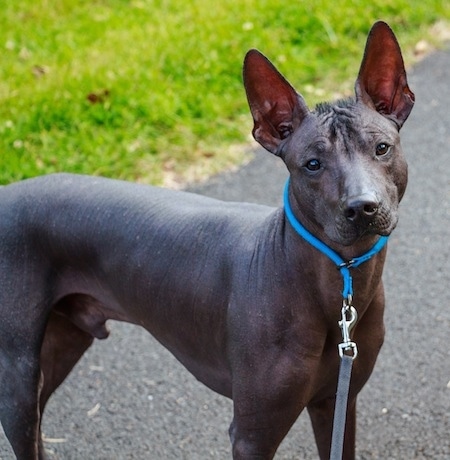
Relic the Xoloitzcuintli at 11 months old—"This is Relic, growing up and maturing into the most amazing dog! He has started his show career and practices obedience on the side. We have introduced him to low-impact agility obstacles to prepare him for his eventual participation in that sport! Relic has energy for days! He is non-stop until about 8PM when it's as if someone hits a switch and he transforms into a total snuggle bug!"
Show-low-its-queen-tli
The Xolo comes in three sizes: Toy, Miniature, Standard, and two varieties: coated and the hairless, with the hairless being the more sought after and popular variety. It is very hairless with or without a short tuft of hair on the head and tail. The hairless Xolo should never be hairy, or possess long hair, wire hair or wavy hair. Its skin should be soft and smooth, yet hardy to the elements. The Xolo comes in a variety of colors, from black to slate, gray, bronze, brindle, red, fawn, solid or spotted. The coated variety should have a full coat of hair that is short, sleek and clean, like that of a Doberman; with regular brushing it sheds very little. The coated Xolo should also not possess long hair, wire or wavy hair. It has a loyal following to those who love the breed but prefer a coat of hair on their dog. In an average litter of five, four will be hairless and one will be coated. This is a very robust and hardy breed, with a broad skull and a black or skin-colored nose. Almond-shaped eyes are dark or in keeping with the color of the dog. Its most noticeable characteristic is its large, upright bat-like ears; it is very keen and can hear and alert you to danger or stranger. Xolos do change colors as they mature.
The Xolo is very intelligent, loyal, alert, athletic and extremely loving to its family. It is important that all family members play a role in leadership, rearing, training and feeding the Xolo or it will bond to the one person or people who do. It is naturally protective and aloof with strangers. With proper socializing it is very good with company and children. It is a myth that Xolos are vegetarians, however they do love veggies. This breed is easy to housetrain, and learns very quickly. You must be the leader and teach the Xolo, or it will lead and run the house for you. This breed is becoming very popular as an obedience dog, in therapy, agility, and conformation. Many swear they have learned more from their Xolo than any other breed, because they are so intelligent and in tune with their family. The Xolo is often called a Velcro dog, staying with its owner at all times, it very seldom runs off or away. One owner’s testament claims she called and called for her Xolo only to look down and find it sitting right there looking up as if to say, “here I am.” So she learned quickly to simply look down first and there it will be. Another owner claims her Xolo loves to climb trees with the kids and ride the horses with the owner. The Xolo can escape anything or climb anything only to get to where you are. However, since they are so smart they can also learn to stay where you want them as long as it is not for forever. Being a primitive breed with great survival skills, a Xolo will not tolerate abuse or an unstable environment. With no shedding, no dander and no fleas, the hairless variety is very popular with clean, neat people, those with allergies and asthma, and with people who suffer from pain and arthritis type ailments. Being hairless, they radiate a warm, soothing, healing heat. This is only because they are hairless, lacking a fur barrier, their body temperature is not warmer. This is not a yappy or hyper breed so do listen when your Xolo alerts you. Do not let the Xolo fall victim to Small Dog Syndrome, human induced behaviors where the dog believes he is pack leader to humans. This will cause varying degrees of behavior issues. Do not treat the dog like a human. Learn canine instincts and treat the dog accordingly, not forgetting the ever-so-important daily pack walk. You will be rewarded many times over with a stable, well-balanced dog.
The Xolo comes in three sizes, The exact sizes vary from breed club to breed club, however in general the sizes are as follows.
Toy: Height 9 - 14 inches (23 - 36 cm) tall at the shoulder.
Toy: Weight 5 - 15 pounds (2.3 - 6.8 kg) In the U.S. the smallest Xolo is called a Toy and in Mexico it is called a Miniature, which can be confusing.
Miniature: Height 15 - 20 inches (38 - 51 cm) tall at the shoulder.
Miniature: Weight 15 - 30 pounds (6.8 - 14 kg) In the U.S. the Miniature is called a Miniature and in Mexico it is called an Intermediate.
Standard: Height 20 - 30 inches (51 - 76 cm) tall at the shoulder.
Standard: Weight 25 - 40 pounds (11 - 18 kg) and up to even 60 + pounds (27 kg)
The Xolo is a very hardy and healthy breed possessing no known breed-related health concerns. A top breeder will keep it that way by breeding only those specimens that have these health qualities, fine skin, temperament and conformation. A breeder who breeds for money and not the health and welfare of the breed may not be concerned with these health qualities, breeding only what they have on hand and not what they should. Breeding is a very big responsibility by the very dedicated fancier. We all know what has happened to many of our very popular breeds in the past and so we all know better than to breed for any other purpose other than the complete health and welfare of this very rare and magnificent breed. Skin health is very important to the hairless variety; a sweater in very cold climates is recommended. Despite what many have read on the Internet, the Xolo's skin is very hardy and requires very little care. In fact over-bathing can strip the skin of natural protection, causing more harm than good. Also over-lotioning and sun screening can clog pores and damage skin, causing acne and such. So only bathe and lotion or sun screen as needed. Let the Xolo's natural protection do its job. Dark-colored and solid-colored Xolos have the hardiest skin; spotted and light colors require more care: See Grooming.
Young Xolos require a lot of exercise, discipline and attention, lots of toys and things to do to keep them happy and out of trouble. If you do not have the time required for the first year, you may consider a trainer, dog walker, or doggy day care while at work all day. Or an older Xolo. As they mature, they calm down and are very easy going, quiet and laid-back, and are content to stay at home while you work. However, they would prefer to go with you if they can and do very well at work with you. This does not mean they are not game to go jogging, hiking or any other activity, it just means they don't require as much as, say, a working breed or terrier breed.
The smaller Xolo was bred as a companion and larger Xolo for protection. No matter which Xolo you choose, they need to be taken on a daily walk. While play can take care of a lot of the smaller Xolo's exercise needs, as with all breeds, it will not fulfill their primal instinct to walk. Dogs that do not get to go on daily walks are more likely to display behavior problems. This breed is very hardy and adapts to many lifestyles, as it comes in many sizes for every need. All hairless breeds must be protected from severe cold and heat as you would yourself, wherever humans are Xolos can also be, providing they can live in the house with you. They make very poor kennel dogs or permanent outdoor pets, as they need to be part of the family. They do crate train very well and even prefer a nice quiet place to call their own for a few hours in the day or at night if they do not sleep with you as most do. Many owners paper train or litter box train the smaller size Xolo, so it does not need to go out in severe winter weather. However, when the weather is nice, no one loves the outdoors as much as a Xolo; they do like to sun bathe and bask in warm weather.
The Xolo is a very long-lived healthy breed. About 15 and up to 20 years is very common.
About 3 to 7 puppies, average of 5
The coated and the hairless variety of Xolo are very easy to groom and care for. For the hairless: Most skin problems arise from poor breeding, neglect or over-bathing and over-lotioning, stripping natural protections and clogging pores. A well-bred hairless Xolo will have very fine, soft skin, yet hardy. Bathe and lotion once or twice a month, or only as needed. Sunscreen as needed as you would yourself in very sunny weather. We do not recommend a ton of products to keep the skin nice, as you might read on the Internet today. Products need not be expensive. An owner claims she buys her Xolo’s bath and lotion products at the dollar store with great success. Top breeders recommend hypoallergenic gentle human products, a nice bath, exfoliating cream, lotion and sunscreen. Keep it simple. Favorite products are: Johnson's bedtime baby bath and lotion with chamomile and lavender. Very calming and soothing to skin and smells great. For the winter dry ear tips and feet: Bag balm or udder butter. For the occasional acne or pimples, especially in teenage Xolos and to keep skin soft and remove dead skin build up: St. Ives exfoliating scrub or similar product. Exfoliate with a buff puff and bath a needed, then lotion with a nice hypoallergenic light product. There are some nice lotions with sunscreen in them. Or a favorite is Bullfrog for babies. People who show or if you are planning an outing and want your Xolo to look his best: Almond oil is nice; also Palmers spray on oil is great for shiny skin and smells nice too! Always bathe after a day out at a show or park to remove unwanted germs and/or dirt and oil buildup. In between baths at home, a warm water rinse is best; wash dirty face and feet with warm water and washcloth. For the coated: Bathe the coated dog as you would any coated breed, brush daily or at least weekly to keep shedding at bay. For both varieties: Clip toenails and brush teeth weekly. Although the dark solid colors do not burn, it is wise to sunscreen any hairless breed as we would ourselves in hot weather. The spotted and white marks can and do sunburn if not protected. The hairless variety is ideal for allergy sufferers because there is no hair to shed. The coated variety, with regular brushing, sheds very little.
The Xoloitzcuintli, also spelled Xoloitzcuintle, is more commonly known as the Mexican Hairless or Xolo. It resembles a robust Manchester Terrier. The Xolo is one of the world’s oldest and rarest breeds, dating back over 3,000 years. Artifacts and clay pottery of this ancient breed have been found in the tombs of Colima, Mayan and Aztec Indians. They were highly prized for their loyalty, intelligence, curative and mystical powers. The Xolo of today remains virtually unchanged. Ancestors of the Aztec Indians brought hairless dogs called "Biche" (meaning naked) with them when they arrived in Mexico from Asia. The Aztecs enjoyed the hairless dogs as pets, but also found them useful as bed warmers, food and sacrificial offerings. The toasty warm body heat of the toy hairless dogs made them in demand as ancient hot-water bottles, relieving stomach pains and rheumatic joints, or simply for warming beds during cold nights. Extreme cold made for a "Three Dog Night." The breed's palliative qualities magnified until its "healing powers" became a cure-all. Clay figures and remains of these dogs, dating from 300 to 900 AD, have been found in burial sites, where dogs guided the souls to a happy afterlife and furnished nourishment until it was reached. The Xolo is native to Mexico and is widespread throughout South America. It is named after the ancient dog Xoloti. At the end of the nineteenth century, it became completely a companion dog. The warmth from these dogs is still enjoyed today, particularly by the elderly. The Xolo is no longer in danger of extinction and is not in danger due to lack of interest. The Xolo today is being acknowledged with increased interest for its companionship, loyalty, cleanliness and flexibility to do it all! They make great companions, show, agility, obedience, therapy and service dogs.
Southern
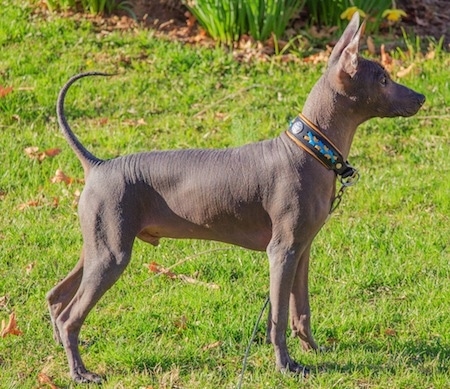
Blancho's Kothoga (AKA Relic) the Xoloitzcuintli as a 6 months old—"This is my boy, Relic! He's growing up to be such a ham! He knows EXACTLY what time he's supposed to eat and if you're late he will roll ALL OVER YOU until you feed him! He's graduated puppy training and is currently in "teenage manners" to learn how to greet people without jumping up! He's remained extremely outgoing which is quite uncharacteristic of the breed!"
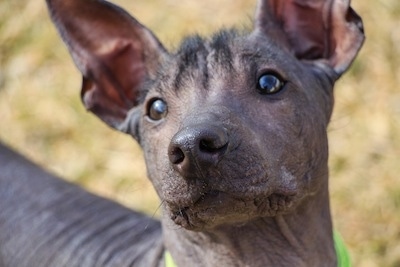
Blancho's Kothoga (AKA Relic) the Xoloitzcuintli as a 6 months old
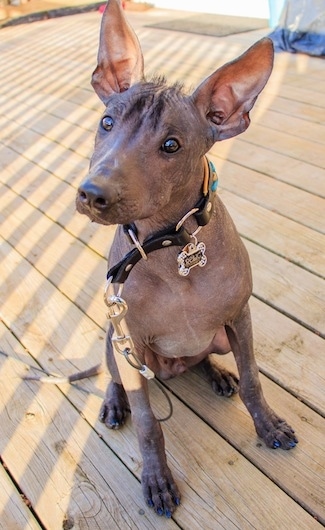
Blancho's Kothoga (AKA Relic) the Xoloitzcuintli as a 6 months old
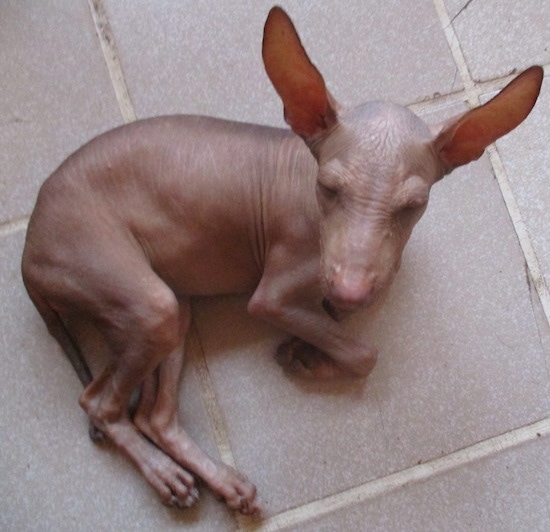
Xochitl the Xoloitzcuintle as a puppy—"Xochitl is a very warm and curious puppy. I mean, literally super warm skin and wants to learn everything. She has taken to house training and walking on a leash with little to no effort on our part. She knows when we are thinking about her. She knows when she needs to think about us. We call her an 'alien' because not only does she stand out in a crowd she is also nothing like anybody else in the crowd. She has very unique powers, it seems. She has helped me with a very challenging case of insomnia. I have learned the Aztecs used these dogs for many reasons and one being it's healing powers for insomnia. The warmth of her skin also helps to reduce the pain of arthritis which creeps in from time to time. She is still so young it is fun to think of the many years to come. Right now, we are so filled with joy and are having an amazing experience growing up with her. She lets us take care of her but that doesn't mean she enjoys the water.... yet. (finger's crossed)."
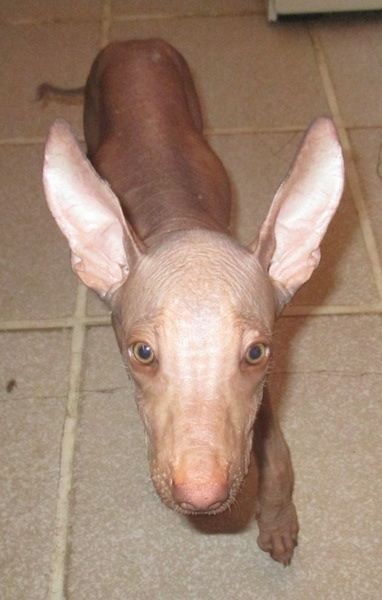
Xochitl the Xoloitzcuintle as a puppy
"Mandrake keeps growing up and he is now becoming a handsome teen coated Xolo. He has learned a lot of things. Still, I'm having trouble teaching him to come at my call, especially when we go to the park and he is distracted by other dogs. I usually have to chase him until I can catch him and put him on his lead to take him home. (He usually thinks I'm playing), this kind of worries me, mostly because of the hazard the passing cars represent. He is 5 months old in these pictures."
Madeena the coated Xolo, photo courtesy of Camino Xoloitzcuintle

Relic the Xoloitzcuintli at 1 1/2 years old—"This weekend Relic earned his AKC Champion title (Ch. Blancho's Kothoga)! He has matured so wonderfully, his teenage stage was really rough, he went through a very dominant stage and he is now coming out the other side after LOTS of work, as a very balanced and chill guy! They say this breed is a nightmare through adolescence, but I would like to URGE anyone with an adolescent Xolo (or any hard-headed teenage dog), please DON'T quit! Adolescent dogs are the most common age to be left at shelters and rescues because it can be very hard, they push you and seem to forget everything they ever learned, but if you stay consistent, ask for help if it gets overwhelming, and you WILL get through it with a great dog that you love all the more because you both understand each other even more than you thought you could!"

Pupe, a 2-month-old Xoloitzcuintli puppy, Mexico City
This is Rico Suave, 17 lbs. of "nekkid" doggie :)